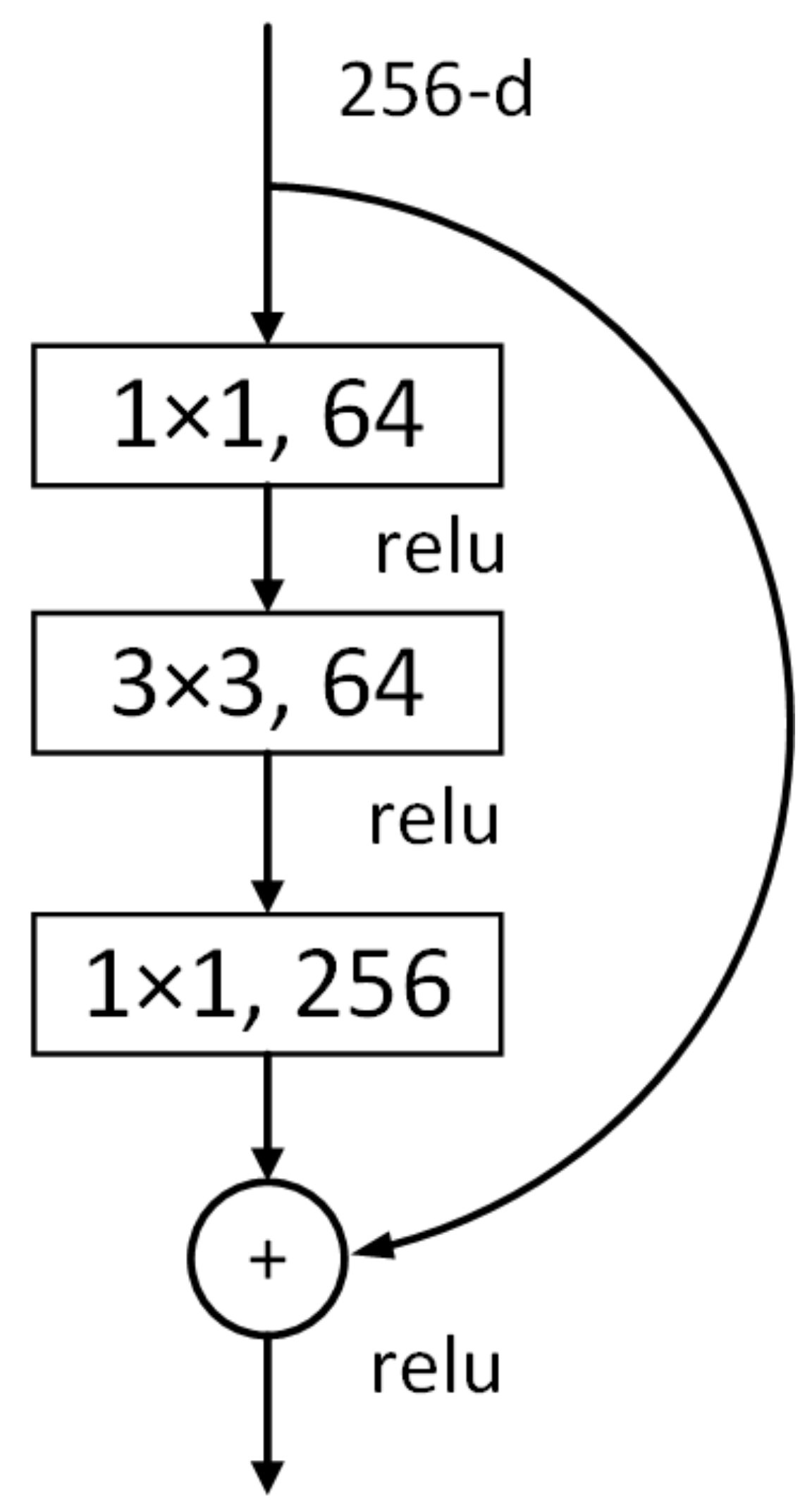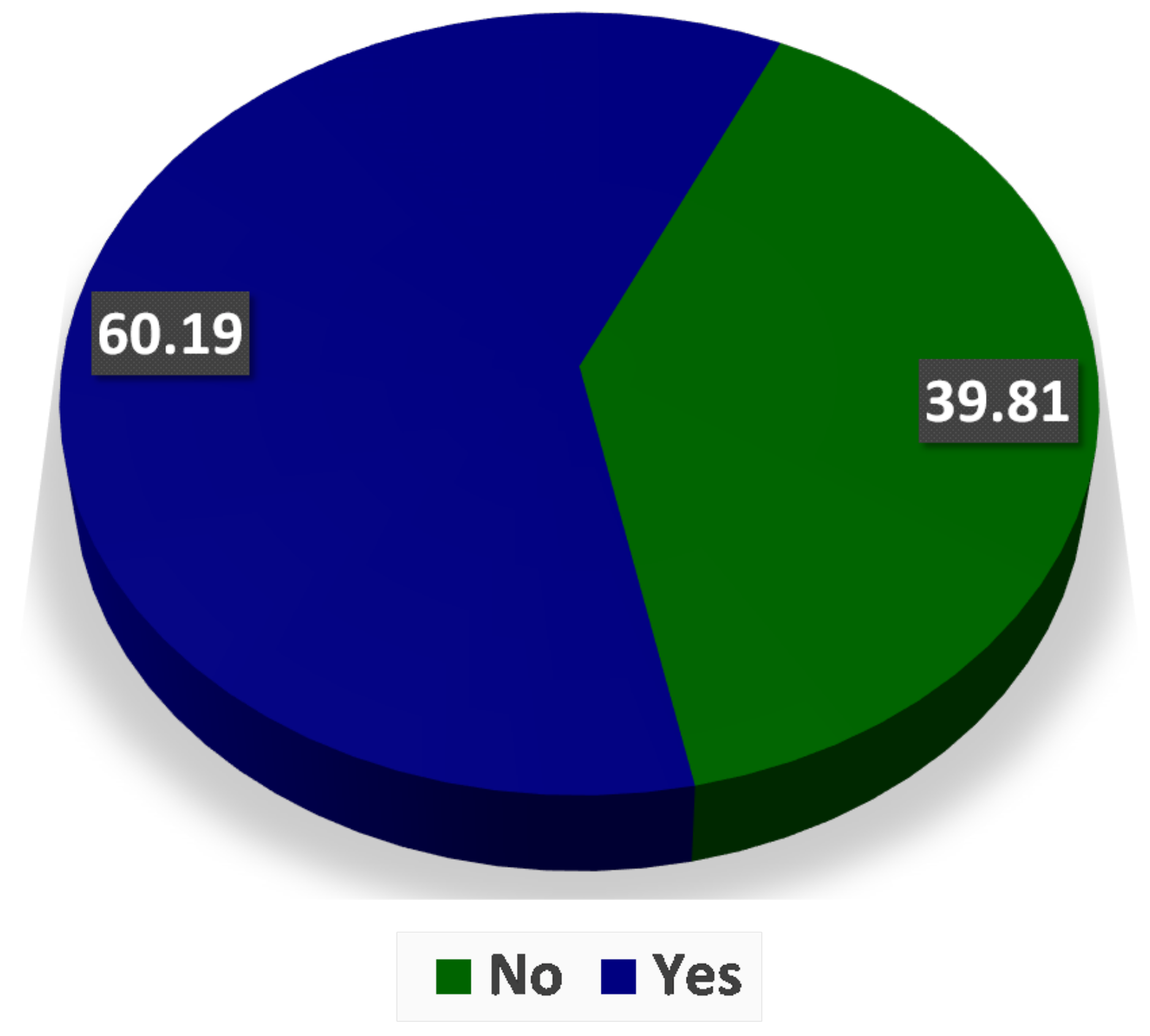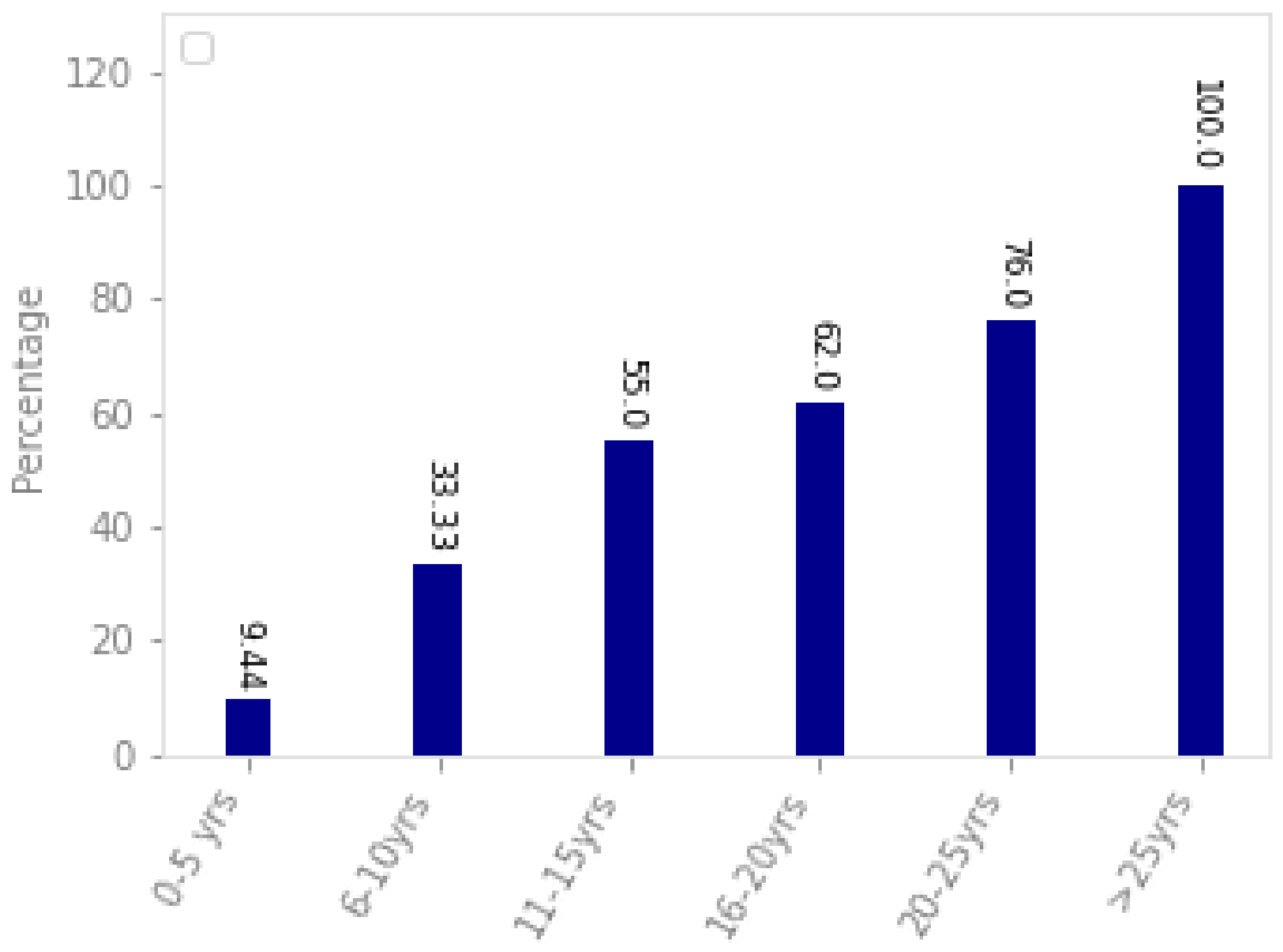ResNet Based Deep Features and Random Forest Classifier for Diabetic Retinopathy Detection †
Abstract
1. Introduction
- The proposed approach for the detection and grading of diabetic retinopathy uses the deep features of a fine-tuned ResNet-50 that are extracted from its pooling layer. The classification is performed using the Random Forest (RF) classifier contrary to the traditional scheme of using the fully connected layer.
- The proposed scheme for feature extraction and classification outperforms existing deep architectures (ResNet-50, VGG-19, Inception-v3, MobileNet, Xception, and VGG16) in terms of execution time and classification accuracy on EyePACS and Messidor-2 datasets for detection and grading of diabetic retinopathy.
- The proposed approach exhibits better results than the existing techniques for the detection and grading of diabetic retinopathy on the above-mentioned two datasets.
2. Related Work
3. Dataset
4. Methodology

5. Experiments and Results
5.1. Environment
5.2. Experiment 1: Messidor
5.3. Experiment 2: EyePACS
5.4. Experiment 3: Execution Time
6. Conclusions and Future Work
Supplementary Materials
Author Contributions
Funding
Acknowledgments
Conflicts of Interest
References
- Wang, X.; Lu, Y.; Wang, Y.; Chen, W.B. Diabetic Retinopathy Stage Classification using Convolutional Neural Networks. In Proceedings of the 2018 IEEE International Conference on Information Reuse and Integration (IRI), Salt Lake City, UT, USA, 6–9 July 2018. [Google Scholar] [CrossRef]
- Shu, D.; Ting, W.; Cheung, C.Y.L.; Lim, G.; Siew, G.; Tan, W.; Quang, N.D.; Gan, A.; Hamzah, H.; Garcia-franco, R.; et al. Development and Validation of a Deep Learning System for Diabetic Retinopathy and Related Eye Diseases Using Retinal Images From Multiethnic Populations With Diabetes. JAMA 2017, 318, 2211–2223. [Google Scholar] [CrossRef]
- Ogurtsova, K.; da Rocha Fernandes, J.; Huang, Y.; Linnenkamp, U.; Guariguata, L.; Cho, N.H.; Cavan, D.; Shaw, J.; Makaroff, L. IDF Diabetes Atlas: Global estimates for the prevalence of diabetes for 2015 and 2040. Diabetes Res. Clin. Pract. 2017, 128, 40–50. [Google Scholar] [CrossRef] [PubMed]
- Shankar, K.; Zhang, Y.; Liu, Y.; Wu, L.; Chen, C.H. Hyperparameter tuning deep learning for diabetic retinopathy fundus image classification. IEEE Access 2020, 8, 118164–118173. [Google Scholar] [CrossRef]
- Gulshan, V.; Peng, L.; Coram, M.; Stumpe, M.C.; Wu, D.; Narayanaswamy, A.; Venugopalan, S.; Widner, K.; Madams, T.; Cuadros, J.; et al. Development and validation of a deep learning algorithm for detection of diabetic retinopathy in retinal fundus photographs. JAMA 2016, 316, 2402–2410. [Google Scholar] [CrossRef] [PubMed]
- Qummar, S.; Khan, F.G.; Shah, S.; Khan, A.; Shamshirband, S.; Rehman, Z.U.; Khan, I.A.; Jadoon, W. A deep learning ensemble approach for diabetic retinopathy detection. IEEE Access 2019, 7, 150530–150539. [Google Scholar] [CrossRef]
- Narsaiah, C.; Manoj, P.; Raju, A.G. Study on Awareness and Assessment of Diabetic Retinopathy in Diabetic Patients Attending Ophthalmology Clinic at a Tertiary Care Hospital, Telangana State. J. Contemp. Med. Res. 2019, 6, K9–K13. [Google Scholar] [CrossRef]
- Bansal, P.; Gupta, R.P.; Kotecha, M. Frequency of diabetic retinopathy in patients with diabetes mellitus and its correlation with duration of diabetes mellitus. Med. J. Dr. Patil Univ. 2013, 6, 366. [Google Scholar]
- Fong, D.S.; Aiello, L.; Gardner, T.W.; King, G.L.; Blankenship, G.; Cavallerano, J.D.; Ferris, F.L.; Klein, R. Retinopathy in diabetes. Diabetes Care 2004, 27, s84–s87. [Google Scholar] [CrossRef]
- Retinopathy, A.D. Diabetic Retinopathy Detection using Deep Convolutional Neural Networks. In Proceedings of the 2016 International Conference on Computing, Analytics and Security Trends, Pune, India, 19–21 December 2016. [Google Scholar]
- Pour, A.M.; Seyedarabi, H.; Jahromi, S.H.A.; Javadzadeh, A. Automatic Detection and Monitoring of Diabetic Retinopathy Using Efficient Convolutional Neural Networks and Contrast Limited Adaptive Histogram Equalization. IEEE Access 2020, 8, 136668–136673. [Google Scholar] [CrossRef]
- Mateen, M.; Wen, J.; Hassan, M.; Nasrullah, N.; Sun, S.; Hayat, S. Automatic Detection of Diabetic Retinopathy: A Review on Datasets, Methods and Evaluation Metrics. IEEE Access 2020, 8, 48784–48811. [Google Scholar] [CrossRef]
- Takahashi, H.; Tampo, H.; Arai, Y.; Inoue, Y.; Kawashima, H. Applying artificial intelligence to disease staging: Deep learning for improved staging of diabetic retinopathy. PLoS ONE 2017, 37, e0179790. [Google Scholar] [CrossRef]
- Asiri, N.; Hussain, M.; Al, F.; Alzaidi, N. Arti fi cial Intelligence In Medicine Deep learning based computer-aided diagnosis systems for diabetic retinopathy: A survey. Artif. Intell. Med. 2019, 99, 101701. [Google Scholar] [CrossRef]
- Abràmoff, M.D.; Lou, Y.; Erginay, A.; Clarida, W.; Amelon, R.; Folk, J.C.; Niemeijer, M. Improved automated detection of diabetic retinopathy on a publicly available dataset through integration of deep learning. Investig. Ophthalmol. Vis. Sci. 2016, 57, 5200–5206. [Google Scholar] [CrossRef]
- Gao, Z.; Li, J.; Guo, J.; Chen, Y.; Yi, Z.; Zhong, J. Diagnosis of diabetic retinopathy using deep neural networks. IEEE Access 2018, 7, 3360–3370. [Google Scholar] [CrossRef]
- Yaqoob, M.K.; Ali, S.F.; Kareem, I.; Fraz, M.M. Feature-based optimized deep residual network architecture for diabetic retinopathy detection. In Proceedings of the 2020 IEEE 23rd International Multitopic Conference (INMIC), Bahawalpur, Pakistan, 5–7 November 2020; pp. 1–6. [Google Scholar]
- Pratt, H.; Coenen, F.; Broadbent, D.M.; Harding, S.P.; Zheng, Y. Convolutional Neural Networks for Diabetic Retinopathy. Procedia Comput. Sci. 2016, 90, 200–205. [Google Scholar] [CrossRef]
- Boudi, Y.; Lamard, M. Deep Image Mining for Diabetic Retinopathy Screening. Available online: http://xxx.lanl.gov/abs/arXiv:1610.07086v3 (accessed on 1 June 2020).
- Akiba, T. Extremely Large Minibatch SGD: Training ResNet-50 on ImageNet in 15 Minutes. Available online: http://xxx.lanl.gov/abs/arXiv:1711.04325v1 (accessed on 1 June 2020).
- Abbas, Q.; Fondon, I.; Sarmiento, A.; Jiménez, S. Automatic recognition of severity level for diagnosis of diabetic retinopathy using deep visual features Co∑on wool spots. Med. Biol. Eng. Comput. 2017, 55, 1959–1974. [Google Scholar] [CrossRef]
- Mansour, R.F. Deep-learning-based automatic computer-aided diagnosis system for diabetic retinopathy. Biomed. Eng. Lett. 2017, 8, 41–57. [Google Scholar] [CrossRef] [PubMed]
- Ghosh, R. Automatic Detection and Classification of Diabetic Retinopathy stages using CNN. In Proceedings of the 2017 4th International Conference on Signal Processing and Integrated Networks (SPIN), Noida, Delhi-NCR, India, 2–3 February 2017. [Google Scholar]
- Ardiyanto, I.; Nugroho, H.A.; Lestari, R.; Buana, B. Deep Learning-based Diabetic Retinopathy Assessment on Embedded System. In Proceedings of the 2017 39th Annual International Conference of the IEEE Engineering in Medicine and Biology Society (EMBC), Jeju Island, Korea, 11–15 July 2017; pp. 1760–1763. [Google Scholar]
- Sriman, N.C.; Iyenger, N. Classification of Diabetic Retinopathy Images by Using Deep Learning Models Classification of Diabetic Retinopathy Images by Using Deep Learning Models. Int. J. Grid Distrib. Comput. 2018, 11, 89–106. [Google Scholar] [CrossRef]
- Yu, S.; Xiao, D.; Kanagasingam, Y. Exudate Detection for Diabetic Retinopathy With Convolutional Neural Networks. In Proceedings of the 2017 39th Annual International Conference of the IEEE Engineering in Medicine and Biology Society (EMBC), Jeju, Korea, 11–15 July 2017; pp. 1744–1747. [Google Scholar]
- Yang, Y.; Li, T.; Li, W.; Wu, H.; Fan, W.; Zhang, W. Lesion Detection and Grading of Diabetic Retinopathy via Two-Stages Deep Convolutional Neural Networks. pp. 1–8. Available online: http://xxx.lanl.gov/abs/arXiv:1705.00771v1 (accessed on 1 June 2020).
- Kanungo, Y.S. Detecting Diabetic Retinopathy using Deep Learning. In Proceedings of the 2017 2nd IEEE International Conference on Recent Trends in Electronics, Information & Communication Technology (RTEICT), Bangalore, India, 19–20 May 2017; pp. 801–804. [Google Scholar]
- Masood, S.; Luthra, T. Identification of Diabetic Retinopathy in Eye Images Using Transfer Learning. In Proceedings of the 2017 International Conference on Computing, Communication and Automation (ICCCA), Greater Noida, India, 5–6 May 2017. [Google Scholar] [CrossRef]
- Kwasigroch, A.; Jarzembinski, B.; Grochowski, M. Deep CNN based decision support system for detection and assessing the stage of diabetic retinopathy. In Proceedings of the 2018 International Interdisciplinary PhD Workshop (IIPhDW), Swinoujscie, Poland, 9–12 May 2018; pp. 111–116. [Google Scholar]
- Garc, G.; Gallardo, J.; Mauricio, A.; Jorge, L.; Carpio, C.D. Detection of diabetic retinopathy based on a convolutional neural network using retinal fundus images. In International Conference on Artificial Neural Networks; Springer: Berlin/Heidelberg, Germany, 2017; pp. 1–8. [Google Scholar]
- Wan, S.; Liang, Y.; Zhang, Y. Deep convolutional neural networks for diabetic retinopathy detection by image classification R. Comput. Electr. Eng. 2018, 72, 274–282. [Google Scholar] [CrossRef]
- Shanthi, T.; Sabeenian, R.S. Modified Alexnet architecture for classification of diabetic retinopathy images R. Comput. Electr. Eng. 2019, 76, 5664. [Google Scholar] [CrossRef]
- Shankar, K.; Rahaman, A.; Sait, W.; Gupta, D.; Lakshmanaprabu, S.K.; Khanna, A.; Mohan, H. Automated detection and classification of fundus diabetic retinopathy images using synergic deep learning model. Pattern Recognit. Lett. 2020, 133, 210–216. [Google Scholar] [CrossRef]
- Rajalakshmi, R.; Subashini, R.; Mohan, R.; Viswanathan, A. Automated diabetic retinopathy detection in smartphone-based fundus photography using arti fi cial intelligence. Eye 2018, 32, 1138–1144. [Google Scholar] [CrossRef]
- Poplin, R.; Varadarajan, A.V.; Blumer, K.; Liu, Y.; Mcconnell, M.V.; Corrado, G.S.; Peng, L.; Webster, D.R. Retinal fundus photographs via deep learning. Nat. Biomed. Eng. 2018, 2. [Google Scholar] [CrossRef]
- Raumviboonsuk, P.; Krause, J.; Chotcomwongse, P.; Sayres, R.; Raman, R.; Widner, K.; Campana, B.J.L.; Phene, S.; Hemarat, K.; Tadarati, M.; et al. Deep learning versus human graders for classifying diabetic retinopathy severity in a nationwide screening program. NPJ Digit. Med. 2019, 2, 1–9. [Google Scholar] [CrossRef]
- Zhang, W.; Zhong, J.; Yang, S.; Gao, Z.; Hu, J.; Chen, Y. Knowledge-Based Systems Automated identification and grading system of diabetic retinopathy using deep neural networks. Knowl. Based Syst. 2019, 175, 12–25. [Google Scholar] [CrossRef]
- Sahlsten, J.; Jaskari, J.; Kivinen, J.; Turunen, L.; Jaanio, E.; Hietala, K. Deep Learning Fundus Image Analysis for Diabetic Retinopathy and Macular Edema Grading. Sci. Rep. 2019, 9, 1–11. [Google Scholar] [CrossRef] [PubMed]
- Zago, G.T.; Andreão, R.V.; Dorizzi, B.; Salles, E.O.T. Diabetic retinopathy detection using red lesion localization and convolutional neural networks. Comput. Biol. Med. 2020, 116, 103537. [Google Scholar] [CrossRef] [PubMed]
- Gargeya, R.; Leng, T. Automated identification of diabetic retinopathy using deep learning. Ophthalmology 2017, 124, 962–969. [Google Scholar] [CrossRef]
- Orlando, J.I.; Prokofyeva, E.; del Fresno, M.; Blaschko, M.B. An ensemble deep learning based approach for red lesion detection in fundus images. Comput. Methods Programs Biomed. 2018, 153, 115–127. [Google Scholar] [CrossRef] [PubMed]
- Voets, M.; Møllersen, K.; Bongo, L.A. Replication study: Development and validation of deep learning algorithm for detection of diabetic retinopathy in retinal fundus photographs. arXiv 2018, arXiv:1803.04337. [Google Scholar]
- Carrera, E.V.; González, A.; Carrera, R. Automated detection of diabetic retinopathy using SVM. In Proceedings of the 2017 IEEE XXIV International Conference on Electronics, Electrical Engineering and Computing (INTERCON), Cusco, Peru, 15–18 August 2017; pp. 1–4. [Google Scholar]
- Decencière, E.; Zhang, X.; Cazuguel, G.; Lay, B.; Cochener, B.; Trone, C.; Gain, P.; Ordonez, R.; Massin, P.; Erginay, A.; et al. Feedback on a publicly distributed image database: The Messidor database. Image Anal. Stereol. 2014, 33, 231–234. [Google Scholar] [CrossRef]
- Abràmoff, M.D.; Folk, J.C.; Han, D.P.; Walker, J.D.; Williams, D.F.; Russell, S.R.; Massin, P.; Cochener, B.; Gain, P.; Tang, L.; et al. Automated analysis of retinal images for detection of referable diabetic retinopathy. JAMA Ophthalmol. 2013, 131, 351–357. [Google Scholar] [CrossRef]
- He, K.; Zhang, X.; Ren, S.; Sun, J. Deep residual learning for image recognition. In Proceedings of the IEEE Conference on Computer Vision and Pattern Recognition, Las Vegas, NV, USA, 27–30 June 2016; pp. 770–778. [Google Scholar]
- Singh, S.; Ho-Shon, K.; Karimi, S.; Hamey, L. Modality classification and concept detection in medical images using deep transfer learning. In Proceedings of the 2018 International Conference on Image and Vision Computing New Zealand (IVCNZ), Auckland, New Zealand, 19–21 November 2018; pp. 1–9. [Google Scholar]
- Simonyan, K.; Zisserman, A. Very deep convolutional networks for large-scale image recognition. arXiv 2014, arXiv:1409.1556. [Google Scholar]
- Howard, A.G.; Zhu, M.; Chen, B.; Kalenichenko, D.; Wang, W.; Weyand, T.; Andreetto, M.; Adam, H. Mobilenets: Efficient convolutional neural networks for mobile vision applications. arXiv 2017, arXiv:1704.04861. [Google Scholar]
- Chollet, F. Xception: Deep learning with depthwise separable convolutions. In Proceedings of the IEEE Conference on Computer Vision and Pattern Recognition, Honolulu, HI, USA, 21–26 July 2017; pp. 1251–1258. [Google Scholar]
- Szegedy, C.; Vanhoucke, V.; Ioffe, S.; Shlens, J.; Wojna, Z. Rethinking the inception architecture for computer vision. In Proceedings of the IEEE Conference on Computer Vision and Pattern Recognition, Las Vegas, NV, USA, 27–30 June 2016; pp. 2818–2826. [Google Scholar]
- Darst, B.F.; Malecki, K.C.; Engelman, C.D. Using recursive feature elimination in random forest to account for correlated variables in high dimensional data. BMC Genet. 2018, 19, 65. [Google Scholar] [CrossRef] [PubMed]
- Suriyal, S.; Druzgalski, C.; Gautam, K. Mobile assisted diabetic retinopathy detection using deep neural network. In Proceedings of the 2018 Global Medical Engineering Physics Exchanges/Pan American Health Care Exchanges (GMEPE/PAHCE), Porto, Portugal, 19–24 March 2018; pp. 1–4. [Google Scholar]
- Kajan, S.; Goga, J.; Lacko, K.; Pavlovičová, J. Detection of Diabetic Retinopathy Using Pretrained Deep Neural Networks. In Proceedings of the 2020 Cybernetics & Informatics (K&I, Velké Karlovice, Czech Republic, 29 January–1 February 2020; pp. 1–5. [Google Scholar]





| Ref. | Proposed | Result | Dataset |
|---|---|---|---|
| 2016, Gulshan et al. [5] | Algorithm based on Inception-V3 | 98.1% specificity, 90.3% sensitivity for EyePacs and 87% sensitivity, 98.5% specificity for the Messidor-2 | EyePACS, Messidor-2 |
| 2016, Pratt et al. [18] | Algorithm to detect diabetic retinopathy by creating heatmaps using ConvNet | 95% sensitivity and 75% validation | EyePACS |
| 2017, Quellec et al. [19] | Data augmentation on CNN-based architecture | 95.4% on EyePACS and 94.9% on e-optha | EyePACS, E-Ophtha |
| 2017, Mansour et al. [22] | AlexNet with multiple optimization techniques | Accuracy of 95.26% with principal component analysis and 97.93% with FC7 features | EyePACS |
| 2017, Gosh et al. [23] | CNN-based model with denoising techniques | Accuracy of 95% and 85% for two and five category problems, respectively | EyePACS |
| 2017, Dutta et al. [25] | Deep neural network with Fuzzy C-means algorithm | 82.3% accuracy | EyePACS |
| 2017, Yang et al. [27] | Two-staged deep CNN with the introduction of an unbalanced weighting map | 95.95% accuracy | EyePACS |
| 2017, Kanungo et al. [28] | Inception-v3 architecture | Accuracy of 82% and 88% for a batch size of 64 and 128, respectively | EyePACS |
| 2017, Masood et al. [29] | Transfer learning on CNN based on pre-trained Inception-V3 | 48.2% accuracy | EyePACS |
| 2018, Kwasigroch et al. [30] | VGG-D architecture with class coding technique | 51% accuracy in the assessing stage and 82% in detecting diabetic retinopathy | EyePACS |
| 2018, Wang et al. [1] | AlexNet, VGG16, and Inception-V3 | 37.43%, 50.03%, 63.23% accuracy, respectively | EyePACS |
| 2018, Garcıa et al. [31] | CNN-based architecture optimized by eliminating noise, performing normalization, and using various hyperparameters | Accuracy of 83.68% with 93.65% specificity | EyePACS |
| 2018, Wan et al. [32] | AlexNet, VGGNet-s, VGGNet-16, VGGNet-19, GoogLeNet, and ResNet after applying transfer learning and hyper-parameter tuning | 89.75%, 95.68%, 93.17%, 93.73%, 93.36%, and 90.40% accuracy, respectively | EyePACS |
| 2019, Qummar et al. [6] | Model based on an ensemble of five CNN models including Dense-169, Xception, Dense-121, ResNet-50, and Inception-v3 | Precision of 84%, 51%, 65%, 48% and 69% for class 0, 1, 2, 3, and 4, respectively | EyePACS |
| 2019, Shanthi et al. [33] | Alexnet based architecture using suitable rectified linear activation Unit, pooling, and softmax layers | 6.6%, 96.2%, 95.6%, and 96.6% accuracy for healthy, stage 1, stage 2, stage 3 cases of diabetic retinopathy, respectively | Messidor |
| 2020, Shankar et al. [34] | Deep learning-based SDL model | 99.28% accuracy | Messidor |
| SG | Messidor-2 |
|---|---|
| 0 | 1593 |
| 1 | 151 |
| Total | 1748 |
| SG | EyePACS |
|---|---|
| 0 | 25,810 |
| 1 | 2443 |
| 2 | 5292 |
| 3 | 873 |
| 4 | 708 |
| Total | 35,126 |
| Data Sets | VGG16 | Xp | M-Net | I-V3 | VGG19 | RN-50 | PA |
|---|---|---|---|---|---|---|---|
| M2 | 95.07 | 93.66 | 92.59 | 92.15 | 87.71 | 81.99 | 96 |
| EP | 74.66 | 71.94 | 74.45 | 74.61 | 74.66 | 74.66 | 75.09 |
| Dataset | Zago [40] | Gar [41] | Orlando [42] | Voets [43] | Carr [44] | PA |
|---|---|---|---|---|---|---|
| Messidor-2 | 94.4 | 94 | 93.4 | 85 | 95 | 96 |
Publisher’s Note: MDPI stays neutral with regard to jurisdictional claims in published maps and institutional affiliations. |
© 2021 by the authors. Licensee MDPI, Basel, Switzerland. This article is an open access article distributed under the terms and conditions of the Creative Commons Attribution (CC BY) license (https://creativecommons.org/licenses/by/4.0/).
Share and Cite
Yaqoob, M.K.; Ali, S.F.; Bilal, M.; Hanif, M.S.; Al-Saggaf, U.M. ResNet Based Deep Features and Random Forest Classifier for Diabetic Retinopathy Detection. Sensors 2021, 21, 3883. https://doi.org/10.3390/s21113883
Yaqoob MK, Ali SF, Bilal M, Hanif MS, Al-Saggaf UM. ResNet Based Deep Features and Random Forest Classifier for Diabetic Retinopathy Detection. Sensors. 2021; 21(11):3883. https://doi.org/10.3390/s21113883
Chicago/Turabian StyleYaqoob, Muhammad Kashif, Syed Farooq Ali, Muhammad Bilal, Muhammad Shehzad Hanif, and Ubaid M. Al-Saggaf. 2021. "ResNet Based Deep Features and Random Forest Classifier for Diabetic Retinopathy Detection" Sensors 21, no. 11: 3883. https://doi.org/10.3390/s21113883
APA StyleYaqoob, M. K., Ali, S. F., Bilal, M., Hanif, M. S., & Al-Saggaf, U. M. (2021). ResNet Based Deep Features and Random Forest Classifier for Diabetic Retinopathy Detection. Sensors, 21(11), 3883. https://doi.org/10.3390/s21113883






